Enhancing Women Workforce Participation: India vs. China Analysis
VerifiedAdded on 2020/07/22
|9
|2360
|44
Report
AI Summary
This report delves into the critical issue of women's workforce participation in India, highlighting its decline despite a high number of female graduates. It examines the government's initiatives, such as safe accommodation and training programs, aimed at promoting gender equality and women's empowerment. The report compares India's situation with China's, emphasizing the need for policy changes, schemes, and movements to enhance women's employment and economic status. It also recommends government-funded childcare systems, fostering a family-friendly environment in workplaces, and providing maternity leave benefits to encourage women's professional engagement. The conclusion underscores the importance of these measures for increasing women's participation in the Indian workforce, improving the country's GDP, and achieving gender equity.
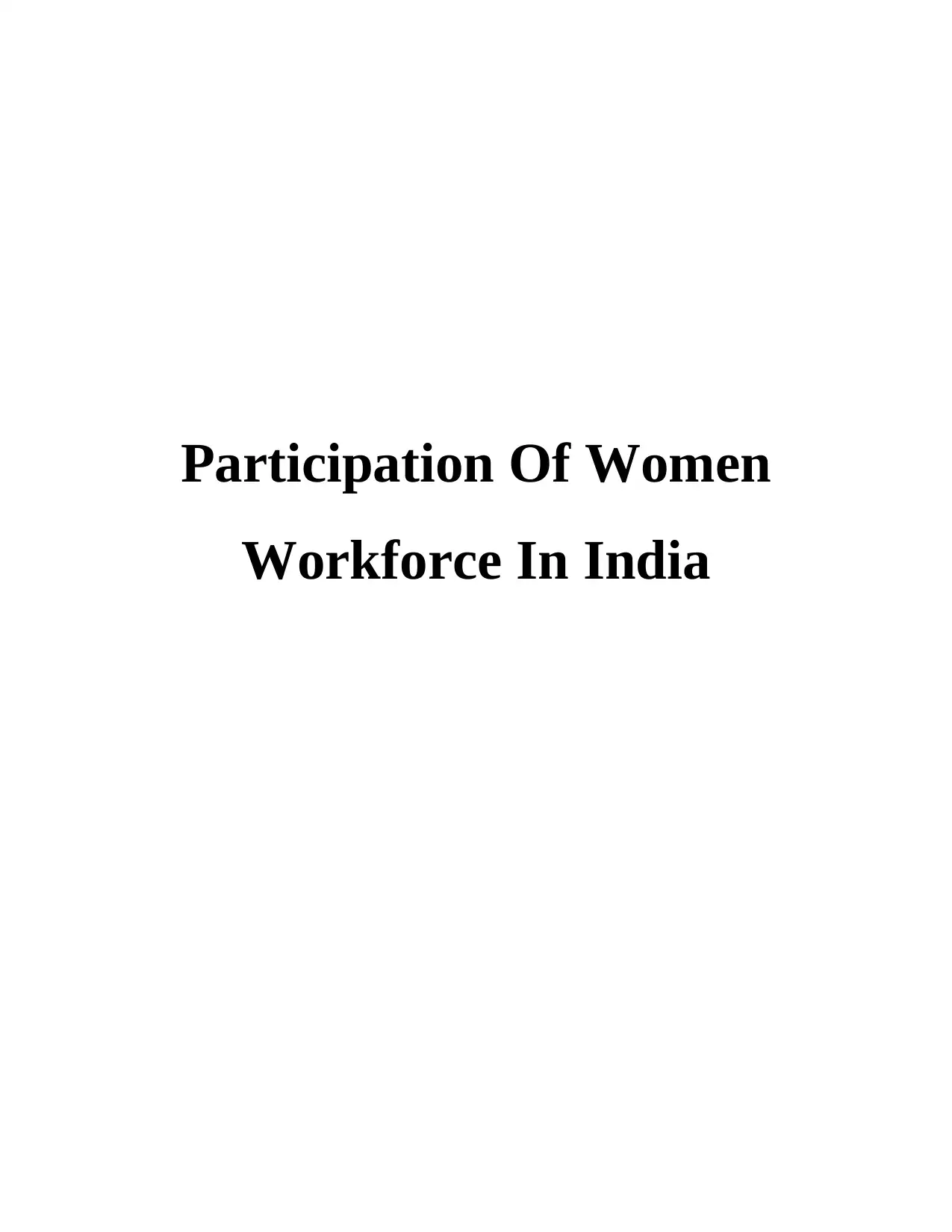
Participation Of Women
Workforce In India
Workforce In India
Paraphrase This Document
Need a fresh take? Get an instant paraphrase of this document with our AI Paraphraser
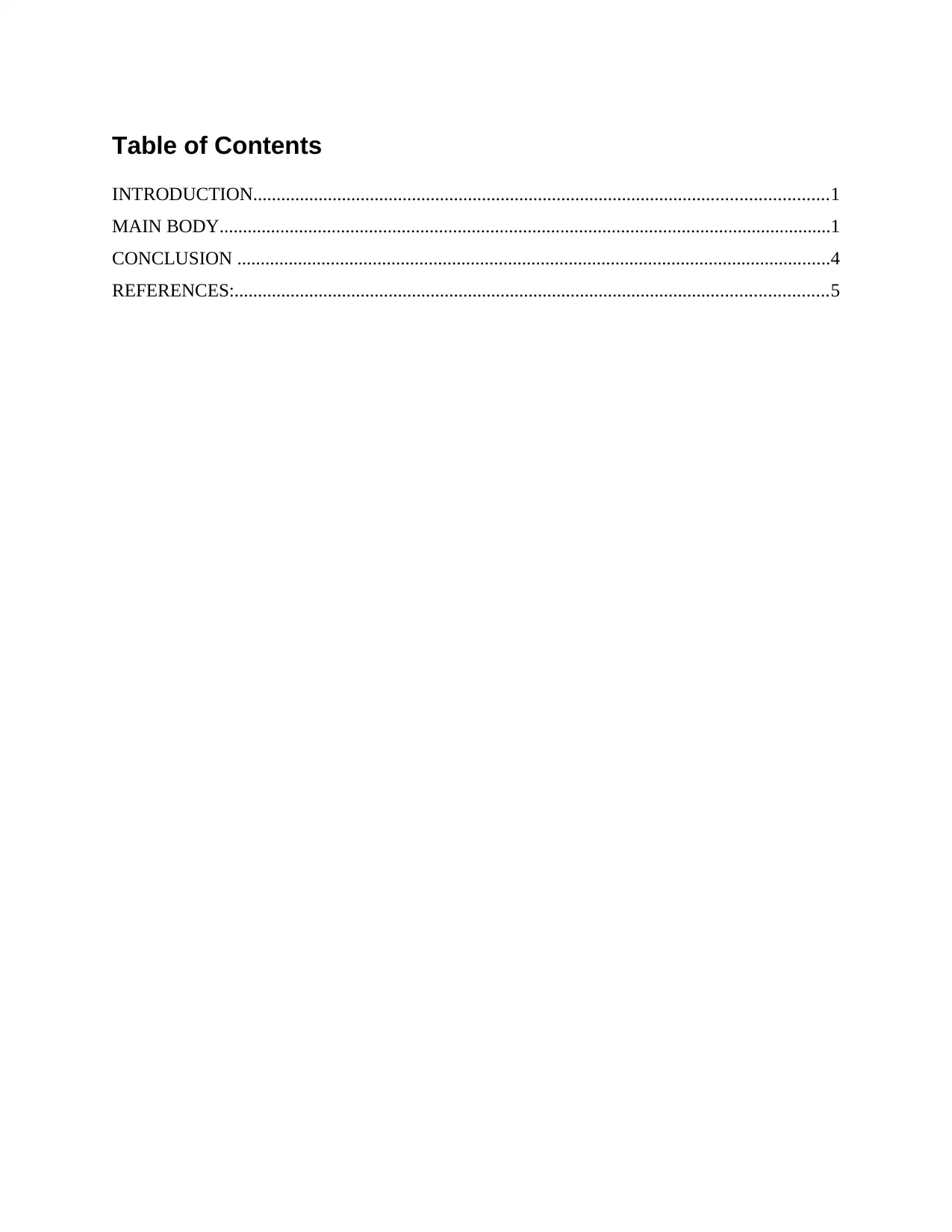
Table of Contents
INTRODUCTION...........................................................................................................................1
MAIN BODY...................................................................................................................................1
CONCLUSION ...............................................................................................................................4
REFERENCES:...............................................................................................................................5
INTRODUCTION...........................................................................................................................1
MAIN BODY...................................................................................................................................1
CONCLUSION ...............................................................................................................................4
REFERENCES:...............................................................................................................................5
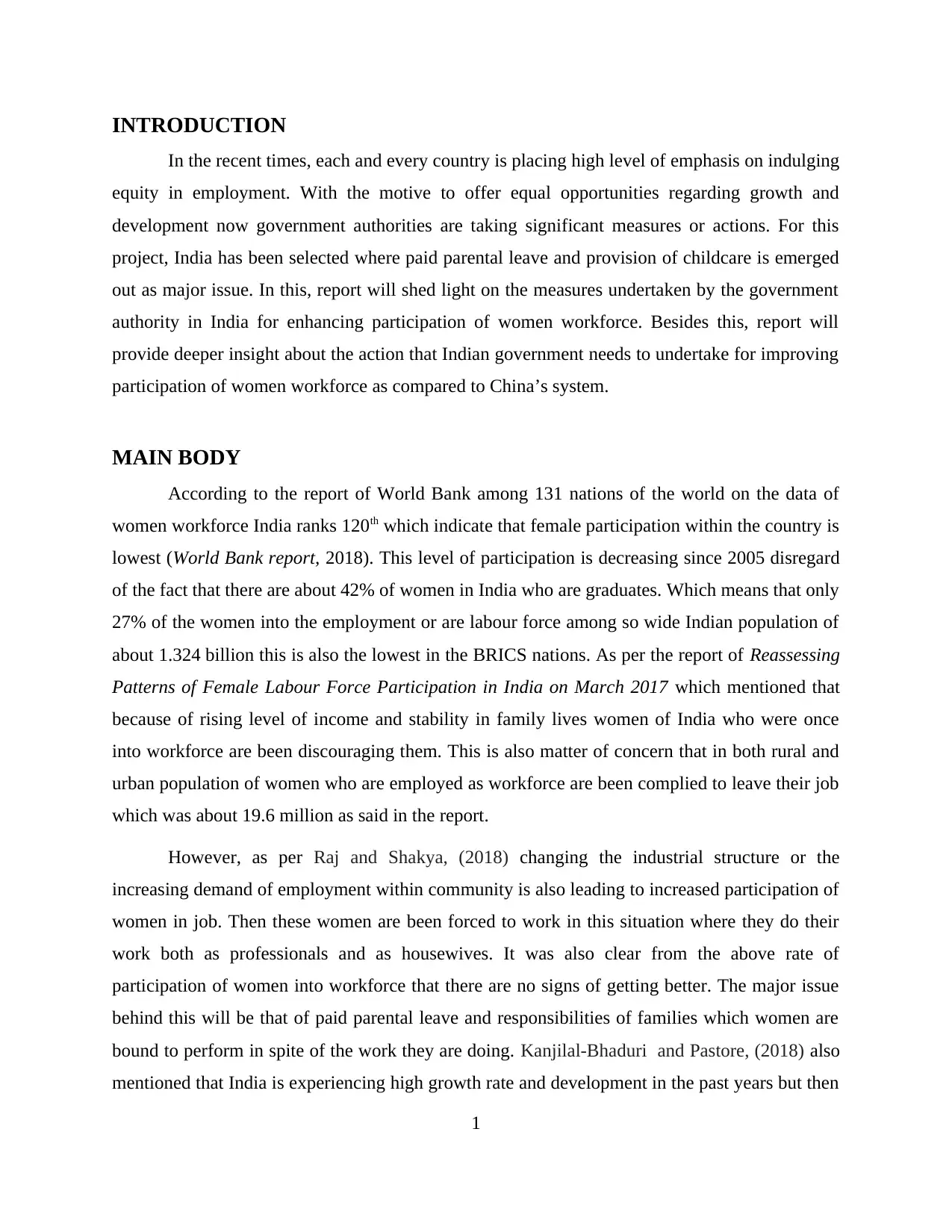
INTRODUCTION
In the recent times, each and every country is placing high level of emphasis on indulging
equity in employment. With the motive to offer equal opportunities regarding growth and
development now government authorities are taking significant measures or actions. For this
project, India has been selected where paid parental leave and provision of childcare is emerged
out as major issue. In this, report will shed light on the measures undertaken by the government
authority in India for enhancing participation of women workforce. Besides this, report will
provide deeper insight about the action that Indian government needs to undertake for improving
participation of women workforce as compared to China’s system.
MAIN BODY
According to the report of World Bank among 131 nations of the world on the data of
women workforce India ranks 120th which indicate that female participation within the country is
lowest (World Bank report, 2018). This level of participation is decreasing since 2005 disregard
of the fact that there are about 42% of women in India who are graduates. Which means that only
27% of the women into the employment or are labour force among so wide Indian population of
about 1.324 billion this is also the lowest in the BRICS nations. As per the report of Reassessing
Patterns of Female Labour Force Participation in India on March 2017 which mentioned that
because of rising level of income and stability in family lives women of India who were once
into workforce are been discouraging them. This is also matter of concern that in both rural and
urban population of women who are employed as workforce are been complied to leave their job
which was about 19.6 million as said in the report.
However, as per Raj and Shakya, (2018) changing the industrial structure or the
increasing demand of employment within community is also leading to increased participation of
women in job. Then these women are been forced to work in this situation where they do their
work both as professionals and as housewives. It was also clear from the above rate of
participation of women into workforce that there are no signs of getting better. The major issue
behind this will be that of paid parental leave and responsibilities of families which women are
bound to perform in spite of the work they are doing. Kanjilal-Bhaduri and Pastore, (2018) also
mentioned that India is experiencing high growth rate and development in the past years but then
1
In the recent times, each and every country is placing high level of emphasis on indulging
equity in employment. With the motive to offer equal opportunities regarding growth and
development now government authorities are taking significant measures or actions. For this
project, India has been selected where paid parental leave and provision of childcare is emerged
out as major issue. In this, report will shed light on the measures undertaken by the government
authority in India for enhancing participation of women workforce. Besides this, report will
provide deeper insight about the action that Indian government needs to undertake for improving
participation of women workforce as compared to China’s system.
MAIN BODY
According to the report of World Bank among 131 nations of the world on the data of
women workforce India ranks 120th which indicate that female participation within the country is
lowest (World Bank report, 2018). This level of participation is decreasing since 2005 disregard
of the fact that there are about 42% of women in India who are graduates. Which means that only
27% of the women into the employment or are labour force among so wide Indian population of
about 1.324 billion this is also the lowest in the BRICS nations. As per the report of Reassessing
Patterns of Female Labour Force Participation in India on March 2017 which mentioned that
because of rising level of income and stability in family lives women of India who were once
into workforce are been discouraging them. This is also matter of concern that in both rural and
urban population of women who are employed as workforce are been complied to leave their job
which was about 19.6 million as said in the report.
However, as per Raj and Shakya, (2018) changing the industrial structure or the
increasing demand of employment within community is also leading to increased participation of
women in job. Then these women are been forced to work in this situation where they do their
work both as professionals and as housewives. It was also clear from the above rate of
participation of women into workforce that there are no signs of getting better. The major issue
behind this will be that of paid parental leave and responsibilities of families which women are
bound to perform in spite of the work they are doing. Kanjilal-Bhaduri and Pastore, (2018) also
mentioned that India is experiencing high growth rate and development in the past years but then
1
⊘ This is a preview!⊘
Do you want full access?
Subscribe today to unlock all pages.

Trusted by 1+ million students worldwide

also gender equity is not one of these developments. Female participation in the Indian market of
workforce is very much important as this will be changing with the socio economic status mainly
during 20th century.
According to the labour reports the participation of women in workforce of India is
different in various states of India and this also varies from each other (Why are millions of
Indian women dropping out of work? 2018). All the women entrepreneur are also creating more
and more jobs for women but this is not clearly seen in India. While women in India in terms of
education are increasing that is about 46.8% of undergraduates are women enrolment and PhD
students are 40% of women. As per the report of ILO the gender pay gap in India is decreasing
with about 57% of women are earning more than men for the same work. The labour force in
India is also increasing which they will be growing to 424 million in next 40 years including
both men and women. There is a direct link between education and employment higher the
number of graduates higher will be the employment level within country (Women In The Labour
Force: India. 2018). But this is not the same case in Indian economy as there are about 67% of
girls who have completed their education then also they are not working or been employed
anywhere as per the report of UNDP.
This is seen that if the country increased this participation of women in the Indian
workforce then GDP of country will be rising to about 60% till 2025. Women in India are
educated but they are not getting the equal paid jobs which they are deserving to get as in one of
the survey of National Sample survey of 2011 (Women’s labour force participation in India:
Why is it so low? 2018). All the sectors of Indian economy like that of telecom, Banking and
health care are the fastest growing but they on same hand are also dominated by men. In India
Skill Report 2017 it was seen that in telecom there are 16.16%, in banking there are 21.21% and
in financial service there are only 25.25% of women who are been employed. The participation
of women in India is only limited and higher in agriculture sector while in others this share is
less than 20%. There is a big question which is still the same as to why Indian women are
dropping out of their job. The reason behind this declining rate of women into job is that of
marriage as after their marriage they are lend to leave job which is not at all affecting male
member of the house. This data range from 2005-2012 to about 20 million of women laving their
jobs and deciding to take care of their family instead of working (Why Indian Workplaces Are
2
workforce is very much important as this will be changing with the socio economic status mainly
during 20th century.
According to the labour reports the participation of women in workforce of India is
different in various states of India and this also varies from each other (Why are millions of
Indian women dropping out of work? 2018). All the women entrepreneur are also creating more
and more jobs for women but this is not clearly seen in India. While women in India in terms of
education are increasing that is about 46.8% of undergraduates are women enrolment and PhD
students are 40% of women. As per the report of ILO the gender pay gap in India is decreasing
with about 57% of women are earning more than men for the same work. The labour force in
India is also increasing which they will be growing to 424 million in next 40 years including
both men and women. There is a direct link between education and employment higher the
number of graduates higher will be the employment level within country (Women In The Labour
Force: India. 2018). But this is not the same case in Indian economy as there are about 67% of
girls who have completed their education then also they are not working or been employed
anywhere as per the report of UNDP.
This is seen that if the country increased this participation of women in the Indian
workforce then GDP of country will be rising to about 60% till 2025. Women in India are
educated but they are not getting the equal paid jobs which they are deserving to get as in one of
the survey of National Sample survey of 2011 (Women’s labour force participation in India:
Why is it so low? 2018). All the sectors of Indian economy like that of telecom, Banking and
health care are the fastest growing but they on same hand are also dominated by men. In India
Skill Report 2017 it was seen that in telecom there are 16.16%, in banking there are 21.21% and
in financial service there are only 25.25% of women who are been employed. The participation
of women in India is only limited and higher in agriculture sector while in others this share is
less than 20%. There is a big question which is still the same as to why Indian women are
dropping out of their job. The reason behind this declining rate of women into job is that of
marriage as after their marriage they are lend to leave job which is not at all affecting male
member of the house. This data range from 2005-2012 to about 20 million of women laving their
jobs and deciding to take care of their family instead of working (Why Indian Workplaces Are
2
Paraphrase This Document
Need a fresh take? Get an instant paraphrase of this document with our AI Paraphraser

Losing Women. 2018). The age of about 15-24 living in both cities and villages of India dropped
out their job which was about 53%. As compared to than more than 24 million men are been
joining their job between the time of 2005-2009 and women leaving their jobs. Many of the
Thakkar and Toyama, (2018) recommanded that Indian women need more better and suitable job
opportunities outside the agriculture sector.
Measures taken by Indian government for improving women participation
National sample survey report (2011-12) presents that workforce participation of males is
higher as compared to females. Moreover, males and females participation accounted for 54.4%
& 21.9% respectively. However, on the other side, considering Indian Country report pertaining
to year 2015, Madheswaran and Singhari (2017) stated that wages offered to women increased
significantly in each sector. Along with this, study presented by author clearly shows that several
actions have taken by the Indian government for enhancing the level of gender equality and
women empowerment. In order to increase participation of women workforce safe
accommodation facilities are introduced by the government (Measures taken by the Government
for gender equality/socio-economic development/empowerment of women, 2018). Such facility
encourages women to move away from their place of residence.
On the critical note, Sarora and Sharma (2018) presented that due to the increasing level
of women harassment and sexual assault participation level is not increased significantly
irrespective of having safe accommodation facility. By doing assessment, it has found that Indian
government is placing high level of emphasis on conducting training & development session for
ensuring sustainable development and income generation of women across the country. Such
initiative which has taken by the government also encourages women to take step for income
generation. Afridi, Dinkelman and Mahajan (2017) argued that India is a male dominated society
where women are rarely encouraged in relation to doing job outside their homes. Further,
biasness in against to certain jobs may also be served as a main cause of poor participation of
women in labor force.
3
out their job which was about 53%. As compared to than more than 24 million men are been
joining their job between the time of 2005-2009 and women leaving their jobs. Many of the
Thakkar and Toyama, (2018) recommanded that Indian women need more better and suitable job
opportunities outside the agriculture sector.
Measures taken by Indian government for improving women participation
National sample survey report (2011-12) presents that workforce participation of males is
higher as compared to females. Moreover, males and females participation accounted for 54.4%
& 21.9% respectively. However, on the other side, considering Indian Country report pertaining
to year 2015, Madheswaran and Singhari (2017) stated that wages offered to women increased
significantly in each sector. Along with this, study presented by author clearly shows that several
actions have taken by the Indian government for enhancing the level of gender equality and
women empowerment. In order to increase participation of women workforce safe
accommodation facilities are introduced by the government (Measures taken by the Government
for gender equality/socio-economic development/empowerment of women, 2018). Such facility
encourages women to move away from their place of residence.
On the critical note, Sarora and Sharma (2018) presented that due to the increasing level
of women harassment and sexual assault participation level is not increased significantly
irrespective of having safe accommodation facility. By doing assessment, it has found that Indian
government is placing high level of emphasis on conducting training & development session for
ensuring sustainable development and income generation of women across the country. Such
initiative which has taken by the government also encourages women to take step for income
generation. Afridi, Dinkelman and Mahajan (2017) argued that India is a male dominated society
where women are rarely encouraged in relation to doing job outside their homes. Further,
biasness in against to certain jobs may also be served as a main cause of poor participation of
women in labor force.
3
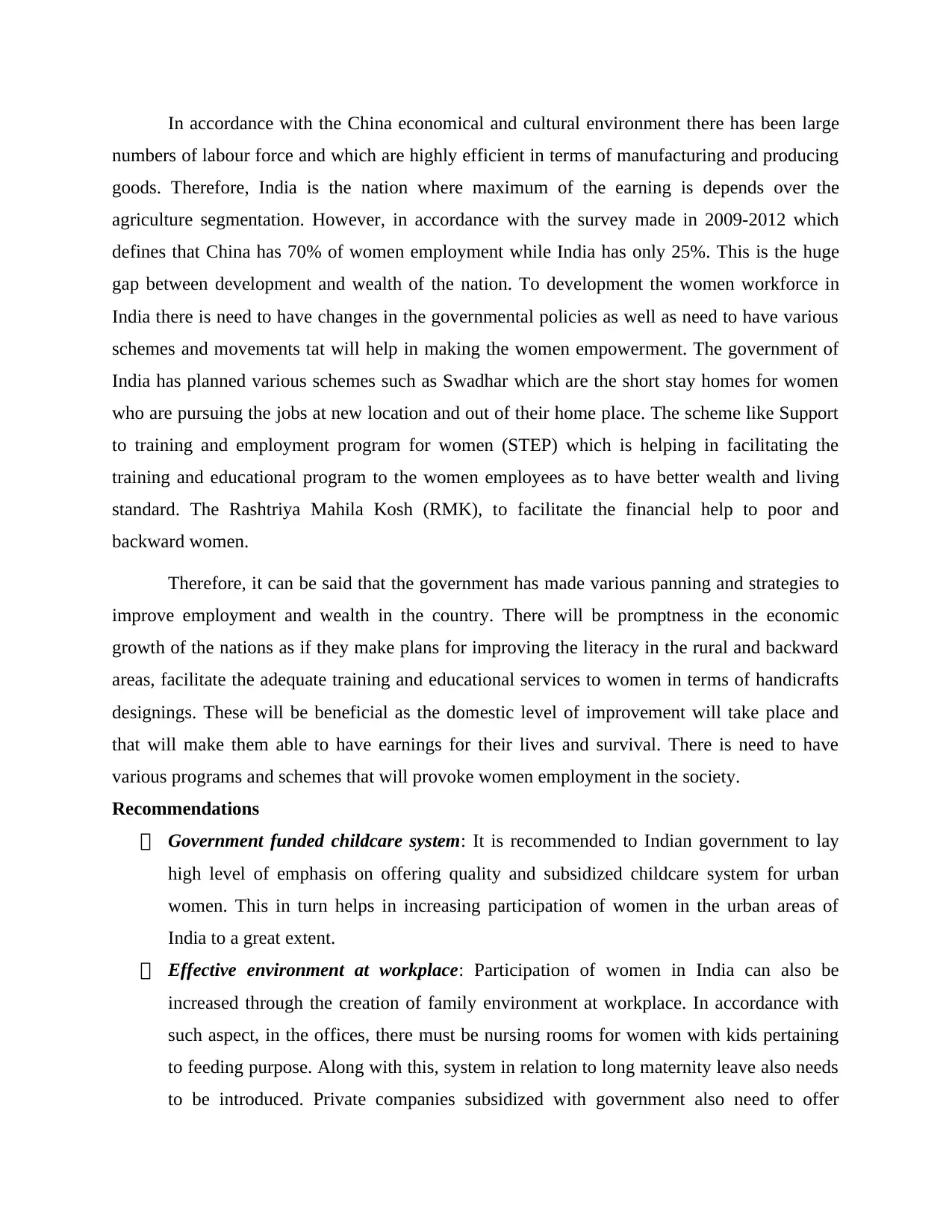
In accordance with the China economical and cultural environment there has been large
numbers of labour force and which are highly efficient in terms of manufacturing and producing
goods. Therefore, India is the nation where maximum of the earning is depends over the
agriculture segmentation. However, in accordance with the survey made in 2009-2012 which
defines that China has 70% of women employment while India has only 25%. This is the huge
gap between development and wealth of the nation. To development the women workforce in
India there is need to have changes in the governmental policies as well as need to have various
schemes and movements tat will help in making the women empowerment. The government of
India has planned various schemes such as Swadhar which are the short stay homes for women
who are pursuing the jobs at new location and out of their home place. The scheme like Support
to training and employment program for women (STEP) which is helping in facilitating the
training and educational program to the women employees as to have better wealth and living
standard. The Rashtriya Mahila Kosh (RMK), to facilitate the financial help to poor and
backward women.
Therefore, it can be said that the government has made various panning and strategies to
improve employment and wealth in the country. There will be promptness in the economic
growth of the nations as if they make plans for improving the literacy in the rural and backward
areas, facilitate the adequate training and educational services to women in terms of handicrafts
designings. These will be beneficial as the domestic level of improvement will take place and
that will make them able to have earnings for their lives and survival. There is need to have
various programs and schemes that will provoke women employment in the society.
Recommendations
Government funded childcare system: It is recommended to Indian government to lay
high level of emphasis on offering quality and subsidized childcare system for urban
women. This in turn helps in increasing participation of women in the urban areas of
India to a great extent.
Effective environment at workplace: Participation of women in India can also be
increased through the creation of family environment at workplace. In accordance with
such aspect, in the offices, there must be nursing rooms for women with kids pertaining
to feeding purpose. Along with this, system in relation to long maternity leave also needs
to be introduced. Private companies subsidized with government also need to offer
numbers of labour force and which are highly efficient in terms of manufacturing and producing
goods. Therefore, India is the nation where maximum of the earning is depends over the
agriculture segmentation. However, in accordance with the survey made in 2009-2012 which
defines that China has 70% of women employment while India has only 25%. This is the huge
gap between development and wealth of the nation. To development the women workforce in
India there is need to have changes in the governmental policies as well as need to have various
schemes and movements tat will help in making the women empowerment. The government of
India has planned various schemes such as Swadhar which are the short stay homes for women
who are pursuing the jobs at new location and out of their home place. The scheme like Support
to training and employment program for women (STEP) which is helping in facilitating the
training and educational program to the women employees as to have better wealth and living
standard. The Rashtriya Mahila Kosh (RMK), to facilitate the financial help to poor and
backward women.
Therefore, it can be said that the government has made various panning and strategies to
improve employment and wealth in the country. There will be promptness in the economic
growth of the nations as if they make plans for improving the literacy in the rural and backward
areas, facilitate the adequate training and educational services to women in terms of handicrafts
designings. These will be beneficial as the domestic level of improvement will take place and
that will make them able to have earnings for their lives and survival. There is need to have
various programs and schemes that will provoke women employment in the society.
Recommendations
Government funded childcare system: It is recommended to Indian government to lay
high level of emphasis on offering quality and subsidized childcare system for urban
women. This in turn helps in increasing participation of women in the urban areas of
India to a great extent.
Effective environment at workplace: Participation of women in India can also be
increased through the creation of family environment at workplace. In accordance with
such aspect, in the offices, there must be nursing rooms for women with kids pertaining
to feeding purpose. Along with this, system in relation to long maternity leave also needs
to be introduced. Private companies subsidized with government also need to offer
⊘ This is a preview!⊘
Do you want full access?
Subscribe today to unlock all pages.

Trusted by 1+ million students worldwide
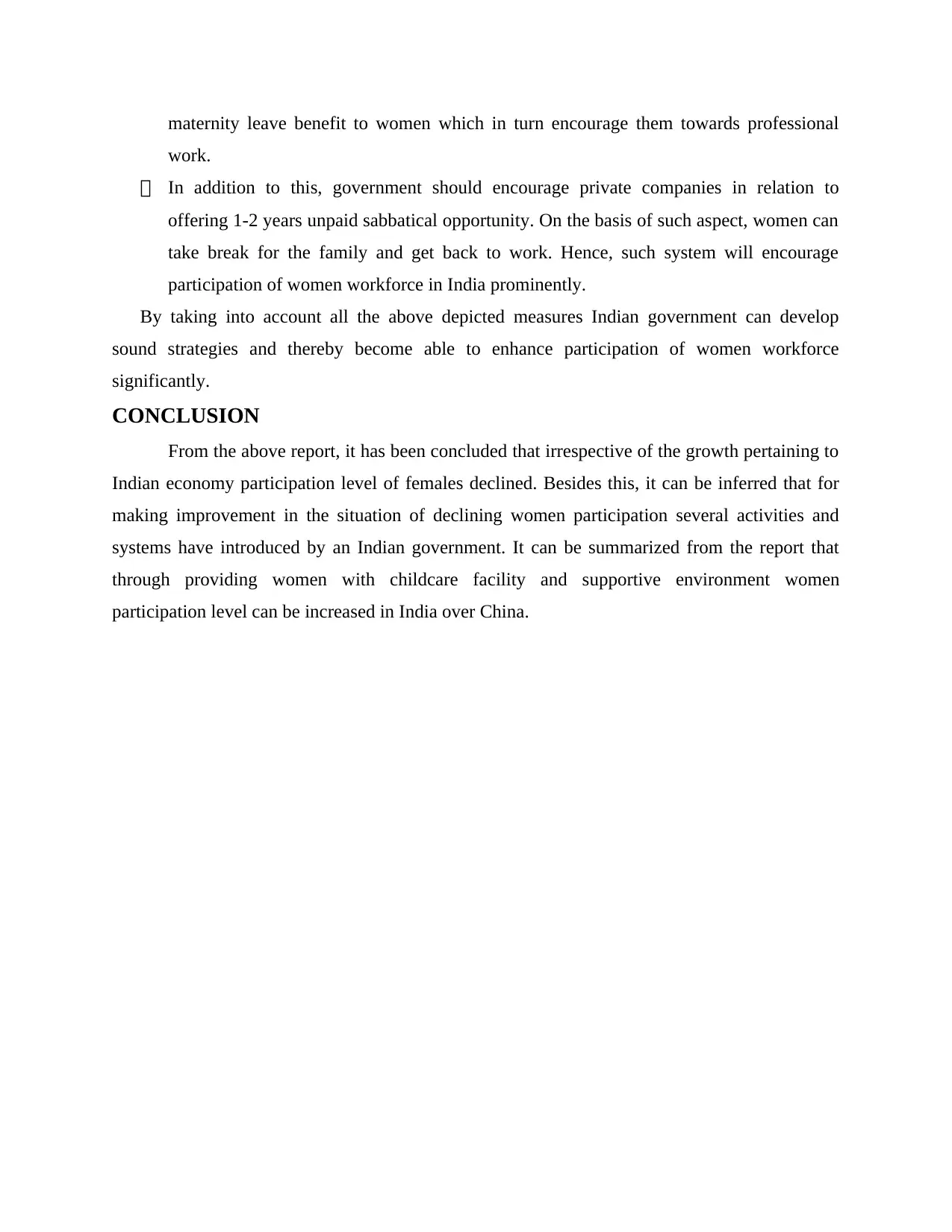
maternity leave benefit to women which in turn encourage them towards professional
work.
In addition to this, government should encourage private companies in relation to
offering 1-2 years unpaid sabbatical opportunity. On the basis of such aspect, women can
take break for the family and get back to work. Hence, such system will encourage
participation of women workforce in India prominently.
By taking into account all the above depicted measures Indian government can develop
sound strategies and thereby become able to enhance participation of women workforce
significantly.
CONCLUSION
From the above report, it has been concluded that irrespective of the growth pertaining to
Indian economy participation level of females declined. Besides this, it can be inferred that for
making improvement in the situation of declining women participation several activities and
systems have introduced by an Indian government. It can be summarized from the report that
through providing women with childcare facility and supportive environment women
participation level can be increased in India over China.
work.
In addition to this, government should encourage private companies in relation to
offering 1-2 years unpaid sabbatical opportunity. On the basis of such aspect, women can
take break for the family and get back to work. Hence, such system will encourage
participation of women workforce in India prominently.
By taking into account all the above depicted measures Indian government can develop
sound strategies and thereby become able to enhance participation of women workforce
significantly.
CONCLUSION
From the above report, it has been concluded that irrespective of the growth pertaining to
Indian economy participation level of females declined. Besides this, it can be inferred that for
making improvement in the situation of declining women participation several activities and
systems have introduced by an Indian government. It can be summarized from the report that
through providing women with childcare facility and supportive environment women
participation level can be increased in India over China.
Paraphrase This Document
Need a fresh take? Get an instant paraphrase of this document with our AI Paraphraser
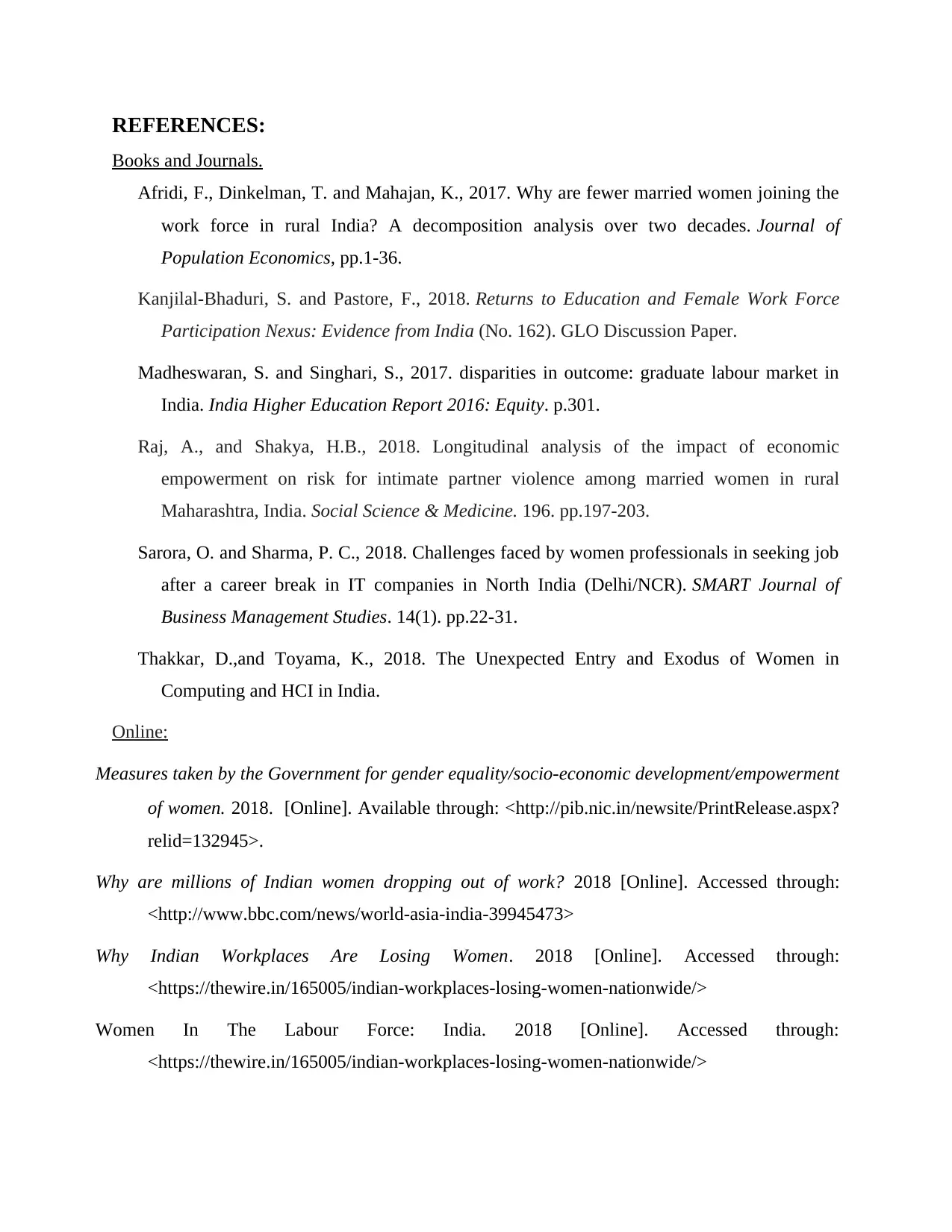
REFERENCES:
Books and Journals.
Afridi, F., Dinkelman, T. and Mahajan, K., 2017. Why are fewer married women joining the
work force in rural India? A decomposition analysis over two decades. Journal of
Population Economics, pp.1-36.
Kanjilal-Bhaduri, S. and Pastore, F., 2018. Returns to Education and Female Work Force
Participation Nexus: Evidence from India (No. 162). GLO Discussion Paper.
Madheswaran, S. and Singhari, S., 2017. disparities in outcome: graduate labour market in
India. India Higher Education Report 2016: Equity. p.301.
Raj, A., and Shakya, H.B., 2018. Longitudinal analysis of the impact of economic
empowerment on risk for intimate partner violence among married women in rural
Maharashtra, India. Social Science & Medicine. 196. pp.197-203.
Sarora, O. and Sharma, P. C., 2018. Challenges faced by women professionals in seeking job
after a career break in IT companies in North India (Delhi/NCR). SMART Journal of
Business Management Studies. 14(1). pp.22-31.
Thakkar, D.,and Toyama, K., 2018. The Unexpected Entry and Exodus of Women in
Computing and HCI in India.
Online:
Measures taken by the Government for gender equality/socio-economic development/empowerment
of women. 2018. [Online]. Available through: <http://pib.nic.in/newsite/PrintRelease.aspx?
relid=132945>.
Why are millions of Indian women dropping out of work? 2018 [Online]. Accessed through:
<http://www.bbc.com/news/world-asia-india-39945473>
Why Indian Workplaces Are Losing Women. 2018 [Online]. Accessed through:
<https://thewire.in/165005/indian-workplaces-losing-women-nationwide/>
Women In The Labour Force: India. 2018 [Online]. Accessed through:
<https://thewire.in/165005/indian-workplaces-losing-women-nationwide/>
Books and Journals.
Afridi, F., Dinkelman, T. and Mahajan, K., 2017. Why are fewer married women joining the
work force in rural India? A decomposition analysis over two decades. Journal of
Population Economics, pp.1-36.
Kanjilal-Bhaduri, S. and Pastore, F., 2018. Returns to Education and Female Work Force
Participation Nexus: Evidence from India (No. 162). GLO Discussion Paper.
Madheswaran, S. and Singhari, S., 2017. disparities in outcome: graduate labour market in
India. India Higher Education Report 2016: Equity. p.301.
Raj, A., and Shakya, H.B., 2018. Longitudinal analysis of the impact of economic
empowerment on risk for intimate partner violence among married women in rural
Maharashtra, India. Social Science & Medicine. 196. pp.197-203.
Sarora, O. and Sharma, P. C., 2018. Challenges faced by women professionals in seeking job
after a career break in IT companies in North India (Delhi/NCR). SMART Journal of
Business Management Studies. 14(1). pp.22-31.
Thakkar, D.,and Toyama, K., 2018. The Unexpected Entry and Exodus of Women in
Computing and HCI in India.
Online:
Measures taken by the Government for gender equality/socio-economic development/empowerment
of women. 2018. [Online]. Available through: <http://pib.nic.in/newsite/PrintRelease.aspx?
relid=132945>.
Why are millions of Indian women dropping out of work? 2018 [Online]. Accessed through:
<http://www.bbc.com/news/world-asia-india-39945473>
Why Indian Workplaces Are Losing Women. 2018 [Online]. Accessed through:
<https://thewire.in/165005/indian-workplaces-losing-women-nationwide/>
Women In The Labour Force: India. 2018 [Online]. Accessed through:
<https://thewire.in/165005/indian-workplaces-losing-women-nationwide/>
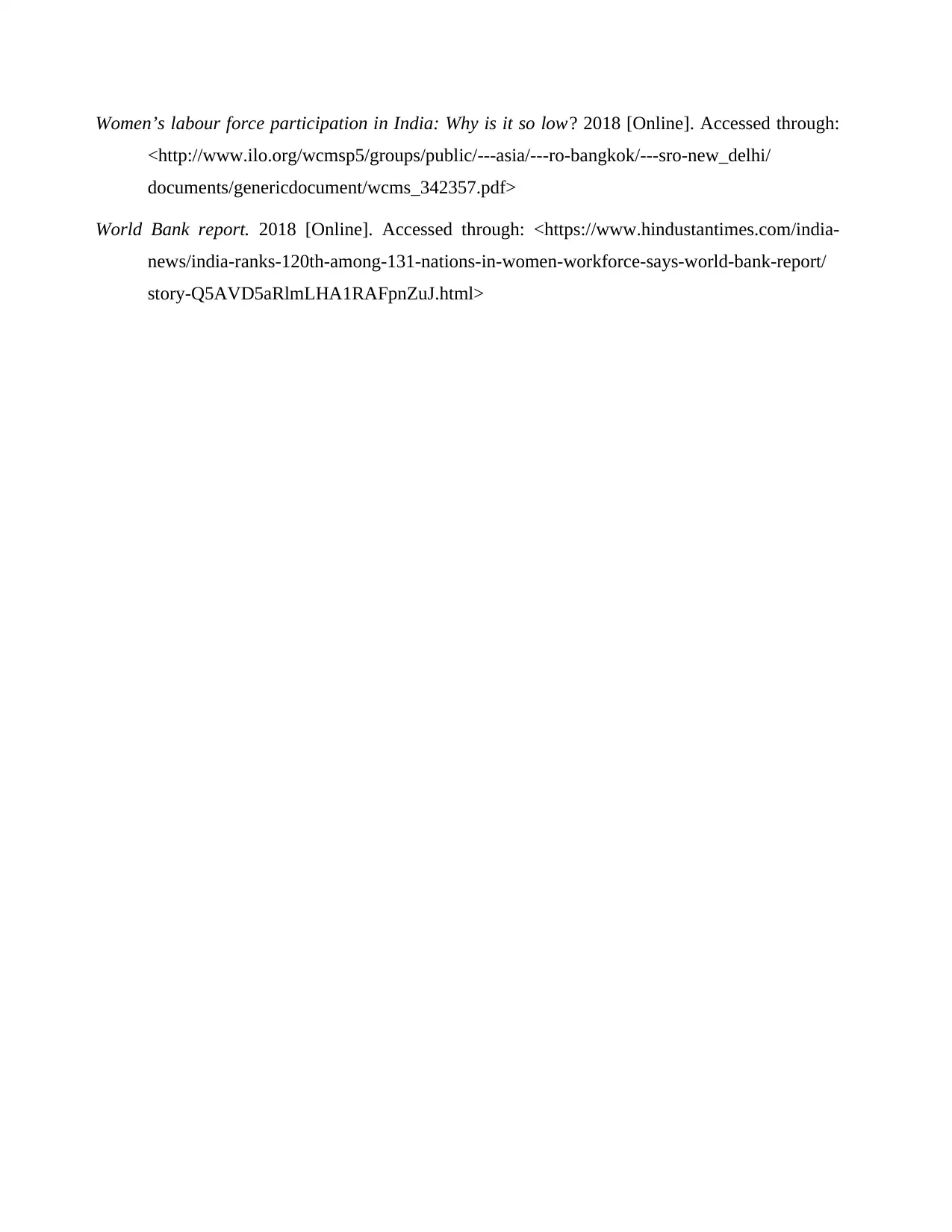
Women’s labour force participation in India: Why is it so low? 2018 [Online]. Accessed through:
<http://www.ilo.org/wcmsp5/groups/public/---asia/---ro-bangkok/---sro-new_delhi/
documents/genericdocument/wcms_342357.pdf>
World Bank report. 2018 [Online]. Accessed through: <https://www.hindustantimes.com/india-
news/india-ranks-120th-among-131-nations-in-women-workforce-says-world-bank-report/
story-Q5AVD5aRlmLHA1RAFpnZuJ.html>
<http://www.ilo.org/wcmsp5/groups/public/---asia/---ro-bangkok/---sro-new_delhi/
documents/genericdocument/wcms_342357.pdf>
World Bank report. 2018 [Online]. Accessed through: <https://www.hindustantimes.com/india-
news/india-ranks-120th-among-131-nations-in-women-workforce-says-world-bank-report/
story-Q5AVD5aRlmLHA1RAFpnZuJ.html>
⊘ This is a preview!⊘
Do you want full access?
Subscribe today to unlock all pages.

Trusted by 1+ million students worldwide
1 out of 9
Related Documents
Your All-in-One AI-Powered Toolkit for Academic Success.
+13062052269
info@desklib.com
Available 24*7 on WhatsApp / Email
![[object Object]](/_next/static/media/star-bottom.7253800d.svg)
Unlock your academic potential
Copyright © 2020–2026 A2Z Services. All Rights Reserved. Developed and managed by ZUCOL.





